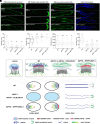AtFH5 recruits and transports the arabinogalactan protein AGP23 to maintain the tip growth of pollen tube
- PMID: 39585983
- PMCID: PMC11626185
- DOI: 10.1073/pnas.2410607121
AtFH5 recruits and transports the arabinogalactan protein AGP23 to maintain the tip growth of pollen tube
Abstract
Actin cytoskeleton drives the targeted transport of cell wall components to sustain the tip growth of pollen tubes for double fertilization; however, the underlying mechanism remains largely unknown. Arabidopsis formin 5 (AtFH5), an actin-nucleating protein, localizes at secretory vesicles and mediates actin polymerization-based vesicle trafficking in pollen. Here, we demonstrate that AtFH5 determines the recruitment and transport of cell wall components in AtFH5-labeled vesicles during the tip growth of pollen tubes. Through a screen of interacting proteins of AtFH5, we identify many cell wall-related proteins, with arabinogalactan protein 23 (AGP23) occupying the highest frequency. AtFH5 interacts with AGP23 via its N-terminal extracellular domain (ECD) and jointly regulate the pollen germination and tube growth process. Further observations reveal that AGP23 co-localizes with AtFH5 at moving vesicles, germination sites, and pollen tube tips, suggesting that AGP23 is delivered by AtFH5-labeled vesicles. Deletion of the ECD of AtFH5 interrupts the dynamic localization and cell-wall connection of AGP23 in pollen grains and tubes. Cytological and genetic evidence shows that AGP23 and AtFH5 work in the same pathway to modulate cell wall composition. Together, our data uncover a role of formin in directing the sorting and deposition of cell wall components via secretory vesicle trafficking during pollen germination and tube growth.
Keywords: AGP23; AtFH5; cell wall; pollen; tip growth.
Conflict of interest statement
Competing interests statement:The authors declare no competing interest.
Figures





Similar articles
-
Actin Polymerization Mediated by AtFH5 Directs the Polarity Establishment and Vesicle Trafficking for Pollen Germination in Arabidopsis.Mol Plant. 2018 Nov 5;11(11):1389-1399. doi: 10.1016/j.molp.2018.09.004. Epub 2018 Oct 6. Mol Plant. 2018. PMID: 30296598
-
Arabidopsis class I formins control membrane-originated actin polymerization at pollen tube tips.PLoS Genet. 2018 Nov 12;14(11):e1007789. doi: 10.1371/journal.pgen.1007789. eCollection 2018 Nov. PLoS Genet. 2018. PMID: 30418966 Free PMC article.
-
Reciprocal regulation between AtFH5-labeled secretory vesicles and PI(4,5)P2 oscillation at the plasma membrane directs pollen germination.J Integr Plant Biol. 2025 Aug;67(8):2229-2244. doi: 10.1111/jipb.13945. Epub 2025 Jun 20. J Integr Plant Biol. 2025. PMID: 40539695 Free PMC article.
-
A RhoGAP controls apical actin polymerization by inhibiting formin in Arabidopsis pollen tubes.Curr Biol. 2024 Nov 4;34(21):5040-5053.e6. doi: 10.1016/j.cub.2024.09.053. Epub 2024 Oct 16. Curr Biol. 2024. PMID: 39419031
-
Membrane trafficking and polar growth in root hairs and pollen tubes.J Exp Bot. 2007;58(1):65-74. doi: 10.1093/jxb/erl059. Epub 2006 Jul 26. J Exp Bot. 2007. PMID: 16873451 Review.
References
MeSH terms
Substances
Grants and funding
LinkOut - more resources
Full Text Sources

